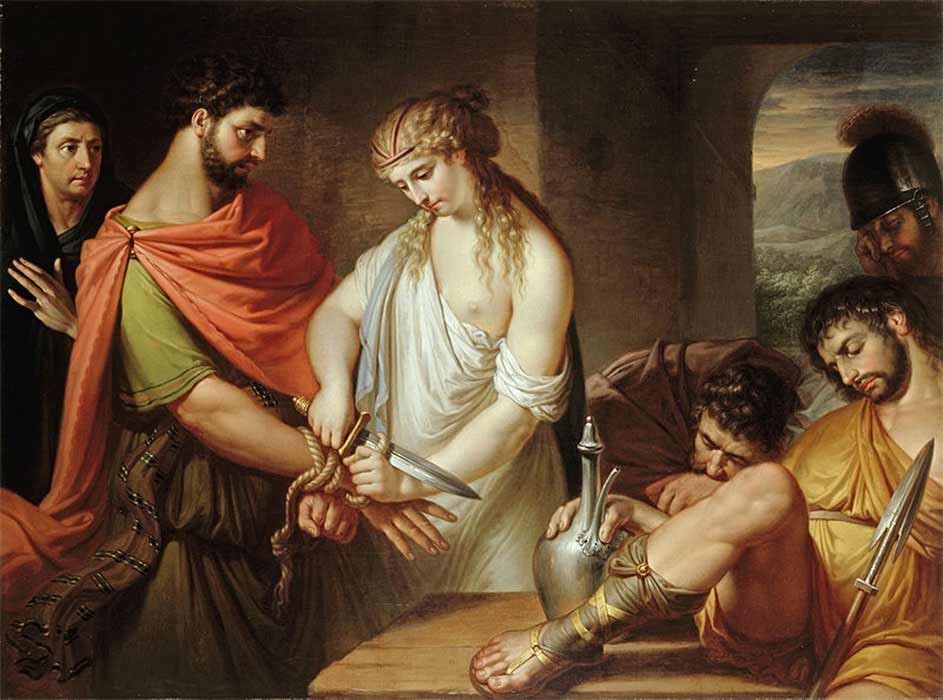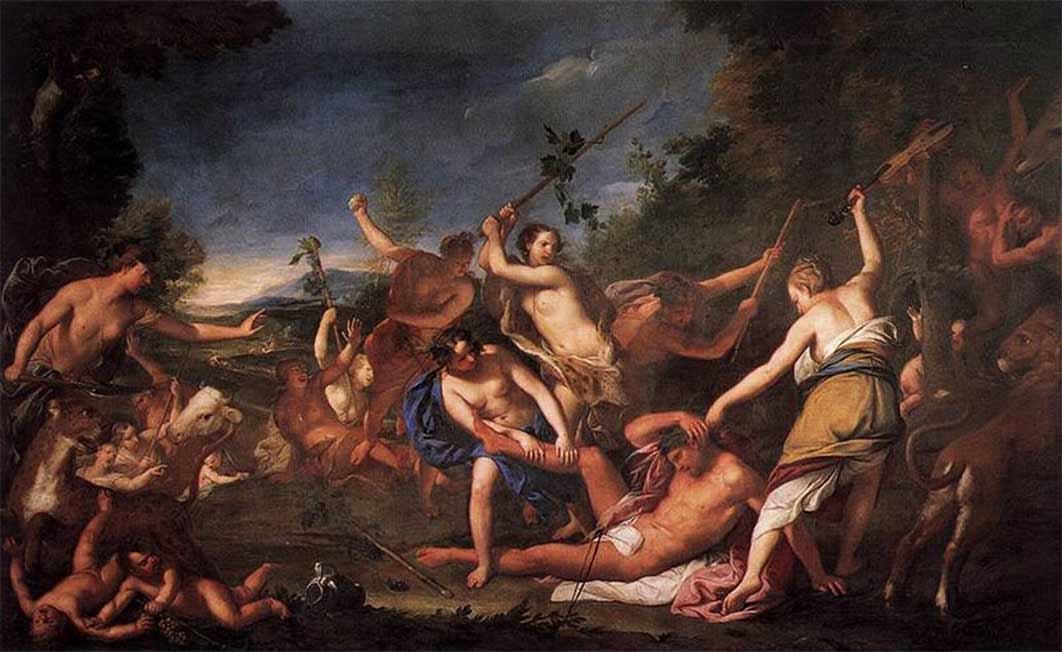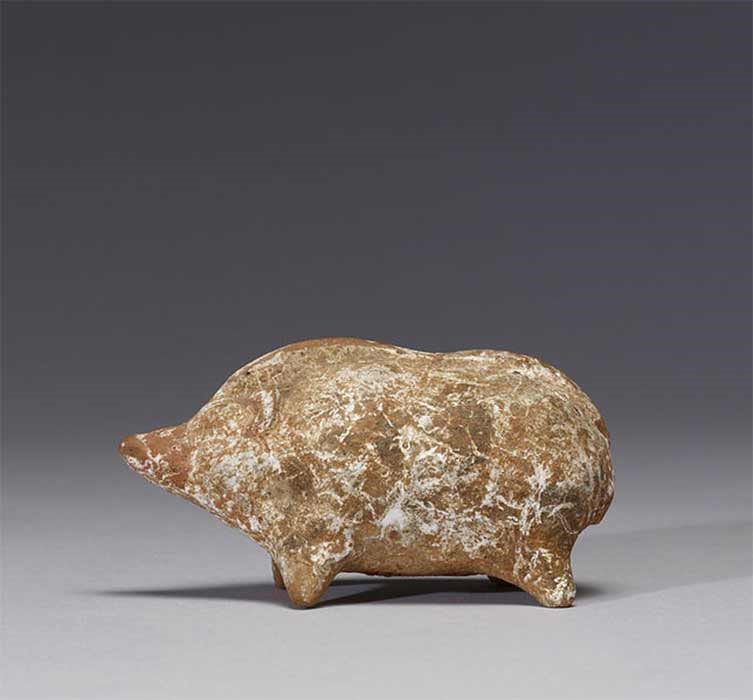The dominant paradigm was turned on its head when subjugated women were made autonomous by participating in a feminine fertility festival known as the Thesmophoria. Devoted to human as well as crop fertility, the Thesmophoria ushered in the sowing season and was one of the most prominent and widespread of all Greek religious festivals. In fact, many believe its universality in the Greek world was testament to its prehistoric origins—a time before patriarchal marriage became the law of the land. Membership was restricted to citizen wives; no maidens, female metics nor slaves were allowed. Depending on the polis, citizen wives left their homes and families for anywhere from three to ten days (and nights) to participate in this festival honoring Demeter, goddess of the harvest, and her daughter, Persephone, queen of the underworld.

Meeting outside the social constructs of marriage, the Thesmophoria evoked a time when women led autonomous lives—without male restrictions. In a society where men set the rules, a community of empowered women that challenged men’s authority struck fear in their hearts but nowhere was this male fear more evident than in the stories about the savagery of the Thesmophoria’s citizen wives. Because men were forbidden—to the point of death—from attending or witnessing any portion of this all-female festival, the Thesmophoria was notorious for its undercurrent of ferocity towards them. Stories abound about men who were subject to life-threatening and disfiguring acts of violence perpetrated by the citizen wives when they spied on or interrupted their festival in any way.
Drawn from ancient sources, some noteworthy examples of the violence of the citizen wives include the following. First there is the tale of the legendary Messenian hero, Aristomenes (ca 720 BCE-648 BCE), celebrated for his triumphs against the fearsome Spartans. Unfortunately for him, he did not fare as well against the well-bred ladies of the Thesmophoria. According to Pausanias (110 CE-180 CE), while during their clandestine celebration, the citizen wives were taken hostage in Demeter’s temple by Aristomenes and his fellow warriors. Hardly shrinking violets, the women—full of the mighty spirit of Demeter—fought the errant warriors furiously with their sacrificial knives and spits. Pausanias recounts the “mortification” of the Messenians. Imagine their humiliation, renowned for their victories against the supreme Spartans, to fall most ignominiously to the second sex. In fact, Aristomenes himself was “knocked senseless” by the hellions and only escaped with his life because of the help he received from one of Demeter’s priestesses—who happened to be his mistress.

Then there is the gruesome lore about the hapless King Battus of Cyrene (ca 650 BCE-600 BCE) –famed for founding Cyrene (Libya). In an account that sounds suspiciously like thwarted rape, an overly curious and perhaps aroused Battus threw himself at the women amid their festival refusing to budge from the sacred all-female rite. Because of his obstinance, Battus was witness to their clandestine rites. Recounted by Claudius Aelienus (175CE-235CE): “Clothed in their holy garments, and wholly possessed because of their initiation into the mysteries, the female slayers brandished their naked swords; their hands and faces were stained with the blood of the victims.” At some point, the ceremony stopped and instead the women turned their attention from butchering the sacrificial victim to butchering Battus: “as if in response to an agreed signal, they leaped upon Battus to remove the part of him that made him a male.” Cruelly castrated by the furious disciples, the legend of King Battus is a warning to Greek men everywhere: payment is steep for violating Demeter’s sacred and secret rites.

Next there is the legend of unlucky Miltiades (555 BCE- 489 BCE)—an Athenian statesman renowned for his role in the Battle of Marathon. While in battle to secure the island of Paros he leapt over the wall leading to the Thesmophorian shrine. Once there, he was so overcome with terror that in jumping back over the wall he sprained his thigh, from which he developed gangrene and later died. The tale is recounted by the historian Herodotus (484 BCE-425 BCE) as an admonishment and warns that this mournful outcome was due to Miltiades breaching the sacred sanctuary of Demeter Thesmophoros.

Finally, there is Plutarch’s (46 CE-120 CE) narrative of Peisistratus (562-527 BCE), the tyrant of Athens, and the Athenian statesman Solon (638 BCE-558 BCE), who pulled a trick on the women of the Thesmophoria while they were celebrating in Megara—a town ten miles from Eleusis. The famed statesmen enlisted two beardless men to impersonate the women in the sacred rites of the Thesmophoria. Ostensibly, it took no time for the enraged disciples to discover the mimics and summarily attack them with their notorious knives and spits.
As violent and disfiguring as these stories may have been, they were deemed justifiable by society at large since the women of the Thesmophoria were acting on Demeter’s behalf. In relation to Plutarch’s narrative above, from his influential lecture on the Greek world, eminent classicist Kevin Clinton maintains: “Whether or not the incident is historical is for our purposes unimportant: the fact is that a celebration of the Thesmophoria at Eleusis was considered unobjectionable.” These narratives all demonstrate men’s profound uneasiness with the female insubordination inherent in the Thesmophoria, yet the festival was all-important to the health and prosperity of the polis thus citizen males turned a blind eye to its subversion. Apropos to the Thesmophoria, from the seminal Greek Religion, the famed Walter Burkett opines: “Men regard this not without suspicion but cannot impede the sacred.”

A summary of stories about the violence of the citizen wives would be incomplete without mention of Aristophanes’ comedic satire Thesmophoriazusae or “Women at the Thesmophoria.” Having fun at a fellow playwright’s expense, Aristophanes casts his colleague Euripides as the character for whom the women of the Thesmophoria want revenge. “Today at the Thesmophoria the women are going to liquidate me because I slander them,” exclaims Euripides. The premise of the play is that the rebellious disciples seek revenge on Euripides for characterizing women in his plays as villainous. Euripides enlists the help of his in-law to impersonate a citizen wife so that he may influence the women at their assembly in Euripides’ favor. Gender inversion is an important theme in this comedy. Although mocked in terms of their democratic assembly, the women are in charge while most of the men at one time or another actively impersonate them—at their peril.
Amid double entendres, there is an undercurrent of violence and Aristophanes’ depiction of the women as uncontrollable, and savage is in keeping with the androcentric mindset towards the festival. While the common thread in all these stories is the Thesmophorians’ unmitigated violence toward men, the patriarchy’s lack of trust for the festival is as notable. In discussing the violence associated with male interference in the Thesmophoria, in his article “The Festival of Bona Dea and the Thesmophoria,” H. S. Versnel asserts: “They (the stories) also most clearly demonstrate that the festival is essentially wrong, disruptive, and consequently in the eyes of one half of society, threatening.” Drawing a primordial connection between the Thesmophorian citizen wives and their ferocious Danaid foremothers—the forty-nine-sisters notorious for slaying their husbands on their wedding night—these vignettes, tellingly reveal the apprehension Greek men felt for the Thesmophoria and its citizen wives.
Besides the subversive misandry inherent in the festival, was there something about the Thesmophoria that encouraged stories of its savagery? At this point it is useful to review the limited rights of women in the Greek world. Wholly without agency, women were treated as children with their every move directed by a male guardian typically in the form of a husband, father, or brother. Accordingly, they were confined to the relative seclusion of their domiciles and restricted from the public domain. Moreover, they were prohibited to own or inherit—even voting was forbidden in this arch-patriarchal society. Make no mistake, the designation “citizen wife” was merely a title conferred on the wife of a male citizen—who was herself the daughter of a male citizen—so that she could bear the much-coveted male citizen. Therefore, it should come as no surprise that the rite of sacrifice which was vital to the health and prosperity of the polis was the purview of the male citizen. Examining the exclusion of Greek women in the realm of sacrifice, Belgian classical scholar Marcel Detienne in his paper titled “The Violence of Wellborn Ladies: Women of the Thesmophoria,” remarks: “Just as women are without political rights, reserved for male citizens, they are also kept apart from altars, meats and blood.” Except for priestesses, women were strictly prohibited from using the instruments of death: knives, spits, and kettles. In fact, in some city-states even priestesses were forbidden to make sacrifices. Entirely incongruous with ideal feminine qualities of subservience and tranquility, the notion of women brandishing instruments of death was the stuff of nightmares for men. Perhaps especially since the Thesmophoria ushered in the sowing season, it had long been assumed by scholars that the festival–like all other feminine festivals–dined on vegetarian fare. But such was not the case.

In fact, it is now acknowledged that the citizen wives performed sacrifices thus access to these murderous implements was required. Archaeological evidence has demonstrated that full-grown sows killed in a sacrificial manner—in which knives were used—were discovered at various Demeter sanctuaries throughout the Greek world. Furthermore, literary artifacts record meat-eating by the women of the Thesmophoria. In discussing a primordial custom, Plutarch reports: “Why at Eretria do the women of the Thesmophoria cook meat in the sun instead of roasting it on the fire?” That the women were eating meat at their festival is indicative that they sacrificed animals. In the previous story about Aristomenes, Pasusanias makes a passing comment that the citizen wives had been sacrificing animals thus fully armed when Aristomenes and his men came upon them.
Even the Lucian scholiast –the source for most of what is known about the rites of the Thesmophoria–confirms that in addition to eating meat, the citizen wives made sacrifices themselves. Consistently unique among fertility festivals, the Thesmophoria was the only feminine cult in the Greek world where sacrifices were performed –without male authority. The confidence that citizen wives made sacrifices at the Thesmophoria cues prominent classics professor, Matthew Dillon in his book Girls and Women in Classical Greece Dillon to opine: “There is nothing in the stories that mitigates against believing that women could slay animals except for the notion that women should not do so.” Aside from anecdotal information, in Delos, financial records from the Thesmophoria between the years of 314 BCE- 166 BCE indicate the purchase of sacrificial animals—namely pigs.
Full-grown sows sacrificed using knives and spits were one of the sacrificial animals used in the ritual. Why pigs? Dating back to Neolithic times, because of their fecundity pigs had long been associated with fertility and harvest and as such are consistently linked to Demeter. On the final day of the celebration, the citizen wives enjoyed roasted pig as part of their culminating feast. But sows were not the only swine that were sacrificed. Sometime before the festival, hundreds of piglets were killed when they were thrown into caverns. This type of sacrifice is depicted on an Athenian lekythos (a long thin krater) showing a disciple crouched over a cavern holding an unfortunate piglet by his tail before flinging him into the dark and deep recesses of the cavern or megara. Always part of the Thesmophorion shrine where the Thesmophoria was celebrated, the cavern symbolized Demeter’s womb. Detienne claims that sacrificing piglets in this manner did not require knives or spits since these animals were simply thrown into the cavern. The piglets, in fact, were killed not for alimentary purposes but because of the sanctity of their rotted remains. Their remains would be retrieved later and become part of the “sacred compost” which was a vital offering to the double goddesses in one of the most sacred of rites.

But not all scholars agree on the type of death the piglets suffered. Dillon suggests that the animals must have been eviscerated before being tossed into the caverns since it would have taken too long for their bodies to decompose otherwise. The reasoning is that there may not have been much time between the killing of the piglets and the scooping up of their remains, thus a high rate of decomposition was essential. From his writings, it is supposed that even Pausanias believed the animals were eviscerated. Moreover, dozens of small terracotta piglets with their stomachs split lengthwise and their organs exposed have been found at various Demeter sanctuaries throughout the Greek world. These figurines could be indicative of the method in which the piglets met their end, though Dillon claims the clay statues may have been used as a substitution for the real thing. Scattering clay replicas of sacrificial animals in place of the dead animals themselves is something that would sometimes occur in Greek religion. However, because pig remains were part of the “sacred compost” to the double goddesses—hence essential to the health and well-being of the polis—some question the clay piglet substitution. Indicative of sacrifice, other figurines common to Demeter sanctuaries include the figurine of a woman carrying a piglet and the figurine of a woman carrying a piglet with one hand and a torch with the other. Presumably, to increase fertility of the crops and of themselves, the women in the figurines are carrying the sacrificed piglet as a gift to Demeter.
The theme of sacrificing women comes up again, this time in Thesmophoriazusae when the in-law, Mnesilochos, who has been impersonating a female disciple at the ritual—is found to be an imposter. To keep himself from getting attacked by the armed and dangerous citizen wives he snatches a baby from one of the celebrants and threatens to sacrifice it at the altar. “You’ll never feed this baby another sop, unless you let me go; nay here atop these thigh-bones by this knife stricken, shall its veins run red. Ensanguinate the altar.” Fear of the armed citizen wife celebrants induces Mnesilochos to stab the hapless infant in a fit of terror. But upon doing so—to his great surprise—the “infant” turns out to be nothing more than a wineskin wrapped in swathing. Like most of the citizen wives in the play, Mica—the infant’s “mother”—is a confirmed lush and deeply distressed about the perforated wineskin. While making every effort to catch the “precious liquid” she cries: “Give me the blood-bowl so at least I can collect my own little one’s blood.” In this spoof of piglet sacrifice, Detienne notes that this act would have no comic effect if the spilled wine/blood were inconsistent with the practices of the Thesmophoria itself. Since they were secret and known only to citizen wives, Aristophanes cannot provide details of the rites, but it was no secret that pigs were involved thus stabbing the wineskin can be seen to resemble stabbing a piglet which individual adherents of the Thesmophoria would have done at the festival. Because of their small size the female adherents would have had no difficulty carrying out the sacrifice of the piglets. Nevertheless, the infamy was not in killing the animals as much as in women—an oppressed and largely segregated population—handling instruments of death.

In her comprehensive book, Citizen Bacchae, noted classicist Barbara Goff, refers to the Thesmophoriazusae as part comedy and part tragedy, opining that the tragic portion represents the grievous narratives of the fate of Battus and Aristomenes which underpins the satire. Doubtless, Aristophanes struck a nerve in his play—and in the hearts of Greek men—by exemplifying the ferocity of the women of the Thesmophoria and their festival’s overt challenge to male authority. The audience, overwhelmingly—if not entirely—composed of men would have been all too familiar with the stories about the female savagery inherent in the Thesmophoria. Though they were suspicious of the Thesmophoria’s subversive nature, because it was the most important of all Demeter feminine fertility festivals—thus vital to the health and prosperity of the polis—men could not oppose it. In contrast, citizen wives—who spent most of the year in subjugation—were empowered by the Thesmophoria’s prehistoric roots which evoked a time before the social construct of marriage, a time when women are believed to have led independent lives. Even though their power was provisional, an oppressed feminine community free from the shackles of male authority and armed to the teeth was a genuine threat to the androcentric rule of ancient Greece. The stories of their violence against men—historical or not—help exemplify that the rebellious and clandestine cult was both fear-inducing and a force with which to be reckoned.
Published in Ancient Origins December 2021
